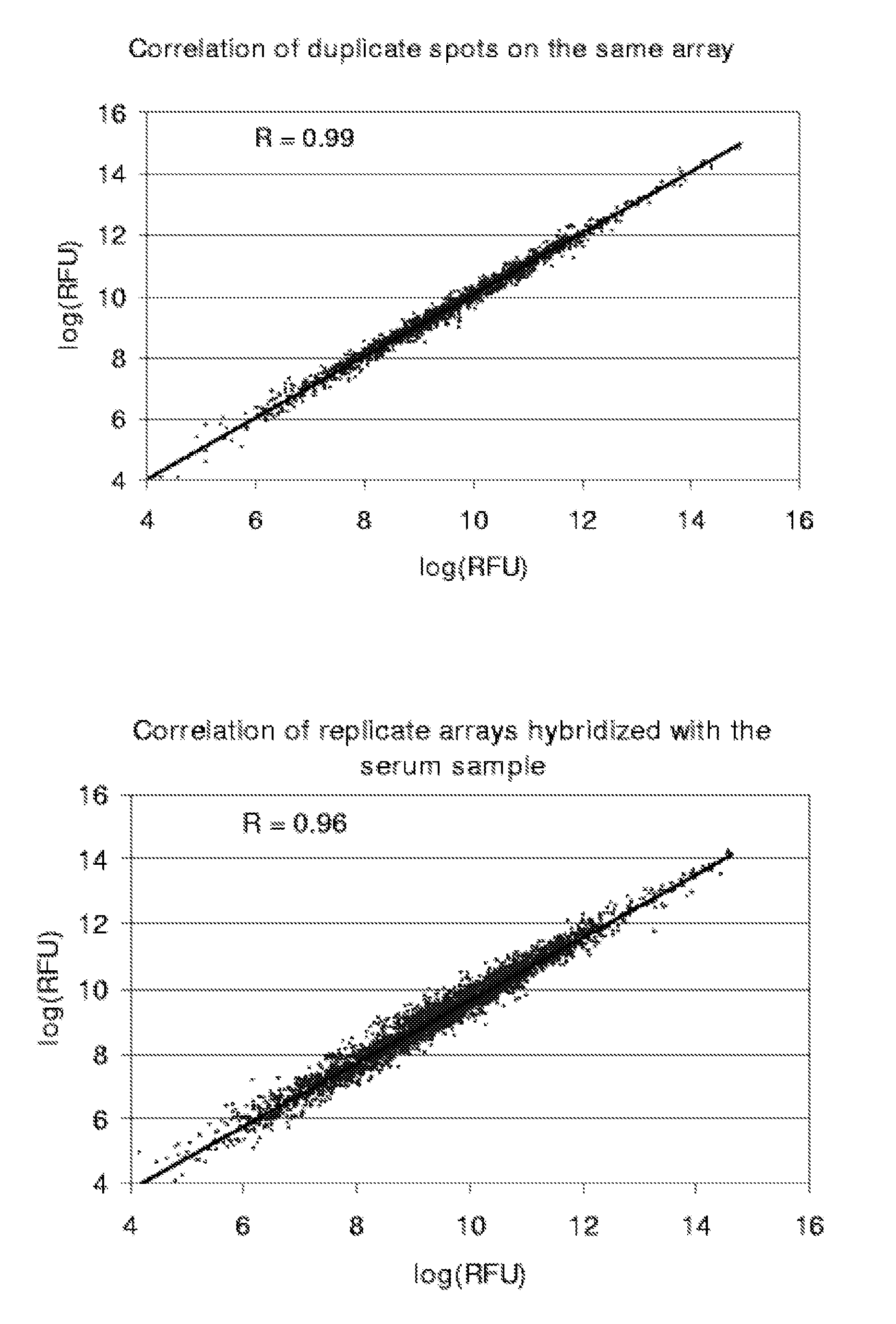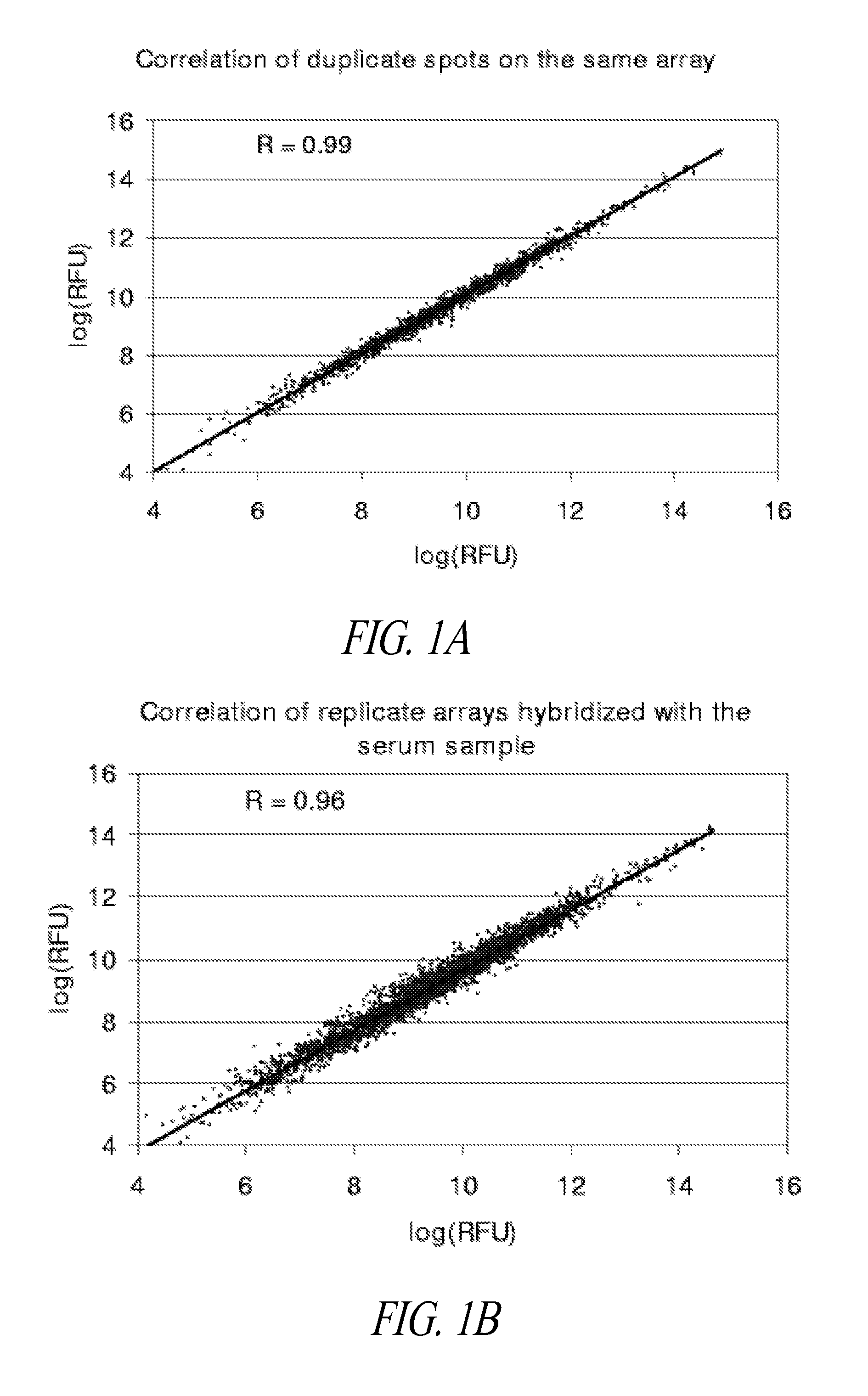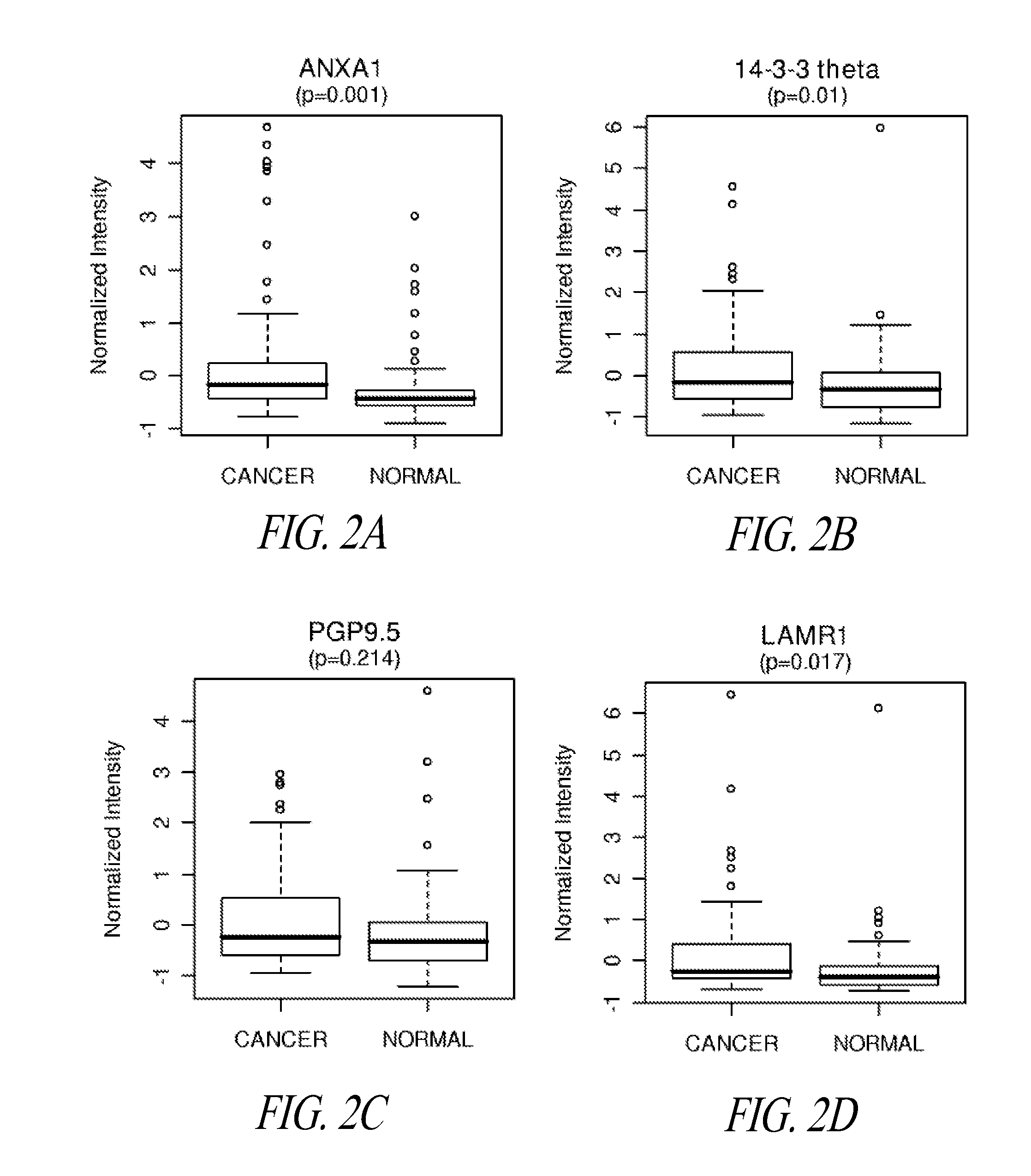Lung cancer diagnosis
a lung cancer and cancer technology, applied in the field of cancer diagnosis, can solve the problems of not being able to achieve the routine screening for lung cancer or early detection of the disease, unnecessary and potentially harmful invasive procedures and/or therapeutic regimens, and not being able to achieve the effect of reducing the burden of tumors and high throughpu
- Summary
- Abstract
- Description
- Claims
- Application Information
AI Technical Summary
Benefits of technology
Problems solved by technology
Method used
Image
Examples
example 1
Materials and Methods
Materials
[0073]Nitrocellulose-coated FAST slides were purchased from Whatman (Sanford, Me.). Alexa 647-labeled anti-human IgG and recombinant protein arrays were purchased from Invitrogen (Carlsbad, Calif.).
[0074]Serum samples and controls were obtained following informed consent. Sera from newly diagnosed lung cancer patients and matched controls were collected through the Community Clinical Oncology Program at the University of Michigan. Pre-diagnostic blood samples from lung cancer patients and matched controls were randomly chosen in pairs from the CARET serum bank (Goodman et al., J Natl Cancer Inst 96:1743-50, 2004; Omenn et al., N Engl J Med 334:1150-5, 1996). The distribution of histology and time from blood draw to diagnosis for the 85 pre-diagnostic lung cancer cases are shown in Tables 1 and 2.
[0075]Natural Protein Microarray Production
[0076]50 mg proteins from the human lung adenocarcinoma cell line A549 lysates were first separated by a...
example 2
Results
[0085]Validation Study of Autoantibodies to Annexin I, PGP9.5, and 14-3-3 Theta in Pre-Diagnostic Sera
[0086]Annexin I, PGP9.5 and 14-3-3 theta were previously identified as inducing an autoantibody response in lung cancer, based on 2D Western analysis of sera from newly diagnosed subjects with lung cancer (Brichory et al., Cancer Res 61:7908-12, 2001; Brichory et al., Proc Natl Acad Sci USA 98:9824-9, 2001; Pereira-Faca et al., Cancer Res 67:12000-6, 2007). Natural protein microarrays were developed to screen tumor-derived proteins for antigens that induce autoantibodies, based on extensive protein fractionation followed by spotting of aliquots from individual fractions (Madoz-Gurpide et al., Proteomics 1:1279-87, 2001). Natural protein containing microarrays were utilized to investigate the occurrence of autoantibodies to annexin I, PGP9.5 and 14-3-3 theta reactivity in pre-diagnostic sera. Serum specimens from the CARET cohort, which consisted of subjects at increased risk ...
example 3
Exemplary Pre-Diagnostic Lung Cancer Indicator Proteins
[0105]
ANNEXIN 1>ipi|IPI00218918|IPI00218918.5 ANNEXIN A1 (SEQ ID NO: 1):MAMVSEFLKQAWFIENEEQEYVQTVKSSKGGPGSAVSPYPTFNPSSDVAALHKAIMVKGVDEATIIDILTKRNNAQRQQIKAAYLQETGKPLDETLKKALTGHLEEVVLALLKTPAQFDADELRAAMKGLGTDEDTLIEILASRTNKEIRDINRVYREELKRDLAKDITSDTSGDFRNALLSLAKGDRSEDFGVNEDLADSDARALYEAGERRKGTDVNVFNTILTTRSYPQLRRVFQKYTKYSKHDMNKVLDLELKGDIEKCLTAIVKCATSKPAFFAEKLHQAMKGVGTRHKALIRIMVSRSEIDMNDIKAFYQKMYGISLCQAILDETKGDYEKILVALCGGN>ipi|IPI00549413|IPI00549413.2 ANNEXIN A1 (SEQ ID NO: 2):MNLILRYTFSKMAMVSEFLKQAWFIENEEQEYVQTVKSSKGGPGSAVSPYPTFNPSSDVAALHKAIMVKGVDEATIIDILTKRNNAQRQQIKAAYLQETGKPLDETLKKALTGHLEEVVLALLKTPAQFDADELRAAMKGLGTDEDTLIEILASRTNKEIRDINRVYREELKRDLAKDITSDTSGDFRNALLSLAKGDRSEDFG>ipi|IPI00643231|IPI00643231.1 ANNEXIN A1 (SEQ ID NO: 3):MAMVSEFLKQAWFIENEEQEYVQTVKSSKGGPGSAVSPYPTFNPSSDVAALHKAIMVKGVDEATIIDILTKRNNAQRQQIKAAYLQETGKPLDETLKKALTGHLEEVVLALLKTP14-3-3 THETA>ipi|IPI00018146|IPI00018146.1 14-3-3 PROTEIN THETA (SEQ ID NO: 4):MEKTELIQKAKL...
PUM
 Login to View More
Login to View More Abstract
Description
Claims
Application Information
 Login to View More
Login to View More - R&D
- Intellectual Property
- Life Sciences
- Materials
- Tech Scout
- Unparalleled Data Quality
- Higher Quality Content
- 60% Fewer Hallucinations
Browse by: Latest US Patents, China's latest patents, Technical Efficacy Thesaurus, Application Domain, Technology Topic, Popular Technical Reports.
© 2025 PatSnap. All rights reserved.Legal|Privacy policy|Modern Slavery Act Transparency Statement|Sitemap|About US| Contact US: help@patsnap.com



